Surgical Orthodontics
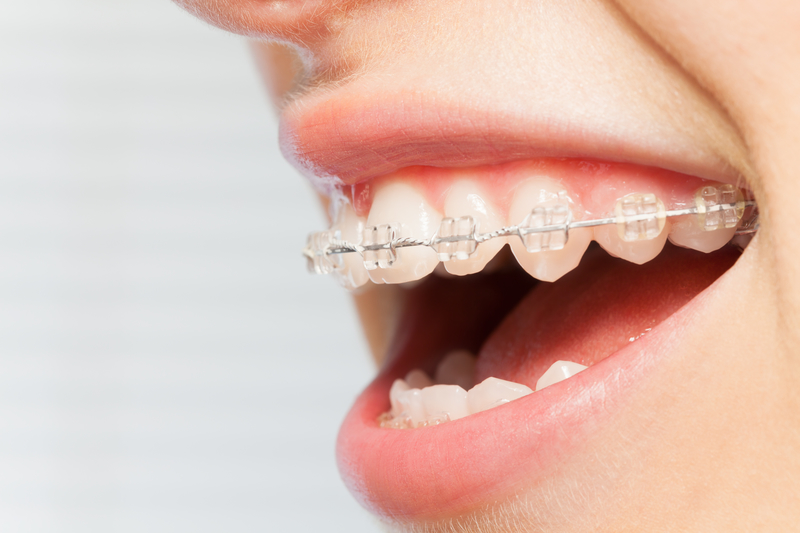
Surgical orthodontics is sometimes needed for those patients whose upper and lower jaws don’t align correctly and a proper bite cannot be achieved. Surgical orthodontics will change the alignment of your jaw, which will affect your teeth. Braces are normally involved in this process to correct teeth movement. Since this is a surgical process, there are many different options for patients to choose from to fix misaligned jaws. Find out whether you’re eligible for surgical orthodontics and what it can do to fix your smile!
What Surgical Orthodontics Entails
In some cases, surgical orthodontics is recommended for patients whose upper or lower jaws do not line up properly and thus cannot obtain a correct bite with orthodontics alone. Known also as jaw surgery or orthognathic surgery, this process involves correcting irregularities of the jaw bone and realigns the jaw and teeth to function together properly. Surgical orthodontics also can be used to fix aesthetic concerns about a patient’s profile or jaw shape/size. Since this type of orthodontic work involves correcting the alignment of your jaw, your teeth will most likely shift, as well, so braces are used in combination with this treatment.
Those patients who suffer from problems with their chewing, breathing, or speaking due to a misaligned jaw are prime candidates for surgical orthodontics. As mentioned earlier as well, patients who have aesthetic facial concerns can also benefit from these treatments to see what improvements can be made, after consulting with their orthodontist. The downside to treatment is that it cannot be performed until a patient’s jaw is fully formed, so for children and children who struggle with any of the aforementioned issues, they must wait to fully develop before any surgery can be performed. For males, jaw growth typically finishes at age 18, and for females it is completed earlier, at around 16 years of age.
What To Expect During Surgery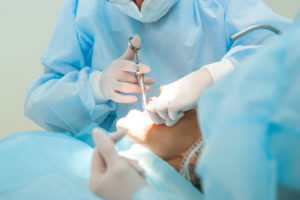
Surgical orthodontics include both pre and post-surgical phases in which treatment is tailored to the individual patient’s needs and jaw structure. Pre-surgery involves aligning your teeth and moving them into a more ideal position before surgery. In many cases, braces are put on 12-18 months prior to surgery to level and align your teeth in preparation for surgery. Orthodontic surgery on your upper jaw can shift it backward, forward, upward, and downward, while surgery on the lower jaw shifts the jawbone either forward or backward. Surgery is performed by an oral surgeon on the inside of the mouth, so there are no facial scars on the mouth, chin, or other surrounding areas. The surgeon makes cuts in the jawbone, which are then moved into the correct position. Tiny bone plates, screws, wires and rubber bands are used to hold the newly aligned jawbone into their new position. While smaller than the bracket that is fixed onto a tooth with braces, these screws eventually become integrated into the bone over time. In some cases, extra bone may be added to the jaw from your hip, leg, or rib, and secured with screws and plates. During your consult with your orthodontist, you will both discuss the pre and post-surgical treatments that you will be receiving, dependent upon your needs.
Post-Surgery Care
After surgery, the oral surgeon will provide you with certain instructions to help in the healing process, such as:
- What you can eat
- Oral hygiene
- Avoiding tobacco
- Avoiding strenuous activity
- Medications to control pain
- Timeline to return to work/school
Typically, you will need to wait at least two weeks after surgery to resume your normal activities. Initial jaw healing occurs at around six weeks, but complete healing can take up to twelve weeks. After the one month post-operation check up, most patients will be in braces for 6-12 months after surgery, in which the orthodontist will then check the progress of your smile and alignment of the jaw. The entire process, including surgery and your time with braces, can last several years, depending on the severity of the issue and what adjustments are needed.
The results of surgical orthodontics are varied and can lead to a balanced appearance of your lower face, improved function of your teeth, health benefits from improved sleeping, eating, and chewing, and improvement in speech impediments. Secondary benefits include improved self-esteem and appearance for those who seek out surgical orthodontics for aesthetic purposes.
Preventing Surgical Orthodontics
It is recommended that children visit an orthodontist between the ages of 7 to 8 for the main purpose of preventing invasive or drastic treatments later on in life. If a jaw abnormality is discovered earlier on in a child’s life, it can be evaluated and treated sooner without surgery having to be involved. If you or your child are suffering from troubled chewing, eating, breathing, or swallowing, or if you have a misaligned jaw, call Belmar Orthodontics at (303) 225-9016 for an evaluation. Our trained staff can help prepare you as you make this important step in your oral health and guide you to a healthier smile.
Rubber Bands and Braces

Why use rubber bands with braces? Some people have them, and some people don’t need to use them at all. Along with brackets, archwires, and ligatures, rubber bands are just another part of braces. Rubber bands are extremely helpful as they help move the teeth and jaw into proper alignment. They are connected to the actual bracket and help improve your bite. If your jaw is misaligned, read on to discover how rubber bands might be the option to straighten your teeth and jaw at the same time!
Parts of Braces
Modern technology has changed the lives, and smiles, of millions of patients worldwide who have used or currently use braces. Nowadays, braces can be as inconspicuous as we want, with some brackets being attached to the backs of teeth, rather than the front, for a more aesthetic appeal. With the invention of a variety of orthodontic appliances, such as lingual braces, Invisalign, clear braces, and traditional, the patient can decide what braces fits their oral health goals the best. Along with the many types of braces we learn about, there are also other parts of braces that we aren’t as familiar with, such as “bracket,” “archwire,” “springs,” and “ligatures.” We have heard of the different components of braces, but what does an archwire do? How do springs help adjust our teeth? Depending on your needs, your orthodontist will install any of these appliances to help you get the best smile in the shortest amount of time possible.
Brackets are the square part of the braces that are directly attached to the tooth, usually through a cement that bonds it to each individual tooth. They are usually made of steel or clear ceramic, and they guide the archwire into the appropriate placement. The archwire is held by brackets and is designed to guide the movement of the teeth during treatment. They are normally made from stainless steel, but also can be made with titanium. Springs go between brackets and around the archwire and are also made of stainless steel or titanium. They function as a force that opens or closes a space between teeth. The archwire and the bracket are connected through ligatures, which are the little rubber bands that wrap around each bracket to hold the archwire in place. For adolescents, these are usually the best part about braces because they come in a variety of colors that kids can choose from, and are changed after each orthodontic visit whenever the archwire is tightened. Although ligatures are rubber bands, they are not the same thing as interarch rubber bands, which have a major impact on jaw and bite alignment.
Rubber Bands
Interarch rubber bands, commonly known as “rubber bands” or “elastics,” ensure that your child’s teeth are lining up properly. They adjust bite and jaw position, such as an overbite or underbite, and are connected to the bracket with hooks. They create a force to move the teeth in a particular direction, specifically closer together. The top and bottom tooth bracket are connected through these bands, which adjusts the position of the teeth in the mouth and the position of the jaw. These rubber bands are removed during meals as well as while cleaning your teeth and brackets. Usually, they are replaced daily because of the wear they endure and their likelihood of breaking if used for too long. When worn to adjust a misaligned bite, interarch rubber bands are typically worn at all times, except for when eating or cleaning your teeth. If the treatment is only minor, you might only have to wear the bands at night. The consistent tension on the teeth and jaw is what makes these bands effective. If a patient doesn’t wear their bands in the prescribed manner, whether it be the length of time is too short or you’re wearing more bands than normal, this can lengthen treatment time and move your teeth in an unintended way. Not every patient will have to use interarch rubber bands, but if your orthodontic prescribes you to wear them, make sure that you follow his or her directions exactly and take good care of your bands.
Do’s and Don’ts of Braces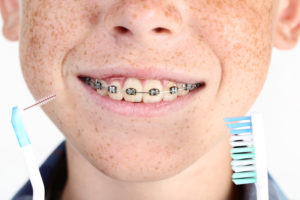
While braces have revolutionized the dental and orthodontic professions, there are some rules that a patient needs to follow to protect and get the most use out of their orthodontic appliances. Always make sure to keep your teeth clean when wearing braces. Brushing and flossing under the archwire and between the brackets is essential to remove plaque, which can easily build up on your teeth with braces. To make sure that your teeth are being cleaned entirely, replace your toothbrush every three months or as soon as the bristles are frayed. Go to all of your orthodontic appointments so that they can adjust your archwire and monitor your teeth’s movement. If you delay your adjustments, your treatment time can be increased, which can be expensive.
Even though braces are strong, you can still break a bracket or an archwire with the things that you eat. Avoid foods that can get stuck in your teeth or your braces, such as nuts, popcorn, hard candy, ice, and sticky foods like chewing gum or caramel. Try not to eat as much sugary foods as it can lead to tooth decay around the brackets, which can permanently damage your teeth. Especially for active teenagers and adults, use a mouthguard during physical activity or when playing a sport to protect your mouth and jaw from getting hurt. Following this list of do’s and don’ts will increase the likelihood of having a positive and shorter experience with braces.
Getting The Smile You Deserve
For other tips and suggestions about orthodontic appliances and which one is best for you, call Belmar Orthodontics at (303) 225-9016 for a comprehensive exam. With our team of qualified and dedicated individuals, we will provide you or your child with the best orthodontic care for a great price. Call now to learn more!
Does Your Child Really Need Braces?

We typically get our braces put on during our teenage to adult years, but how do you know whether your young child should have braces or not? Child orthodontics is a common practice for those children struggling with crooked, overlapping, or overcrowded teeth, or a misaligned jaw. There are many advantages for children as they receive braces earlier on in life as it can prevent future orthodontic treatment and guide incoming teeth into the proper position. Learn how to recognize whether your child needs braces through these tips!
When To Start
Young kids go through a lot of physical changes during adolescence, and some of those changes include jaw and teeth development. Orthodontics has become more and more common in young children to adjust certain orthodontic issues that occasionally occur as a child develops. Traditionally, orthodontic treatment begins once a child has lost most of their baby (primary) teeth and a majority of their permanent teeth have grown in, which typically occurs between the ages of 8 and 14. Even though braces is recommended at this age, it is a good idea to get an orthodontic evaluation for your child by the time they turn 7 years old; at this age, an orthodontist is able to detect early symptoms of orthodontic problems, such as an underbite or crossbite, which can cause severe complications and more treatment later on if left untreated at an early age. Bones are still growing during this age, so it is an ideal time to meet with an orthodontist to monitor bone and jaw development while evaluating any apparent orthodontic issues.
Advantages of Child Orthodontics
Although child orthodontics is only necessary if there are physical developmental issues within the mouth, receiving orthodontic treatment as a child has certain advantages. Visiting an orthodontist at an early age allows for observation of incoming teeth and reduces the risk of impacted teeth as your child loses their baby teeth and their permanent teeth take their place. As the orthodontist monitors your child’s teeth, they can help guide their teeth into the correct position as soon as they begin erupting, usually through braces or other orthodontic devices that help move teeth into the correct positions. Regular orthodontic visits also decrease the risk of hidden dental issues and permanent tooth extractions, as it allows for the orthodontist to adjust the jaw so that teeth crowding doesn’t occur.
Child orthodontics doesn’t always imply braces. Since a child’s jaw and teeth are still growing, many orthodontic issues, such as crowding, can be addressed before complications occur later on during adolescence. In this case, orthodontic treatment in young children is known as interceptive orthodontics. Many times, a child’s dental arch may be too small to fit all of their teeth. Just a few decades ago, it was a common practice to simply remove some permanent teeth to make space in the mouth. Now, though, child orthodontics can avoid this through the use of a palatal expander that expands the child’s upper dental arch, which allows adult teeth to emerge in a better position. Interceptive orthodontics can speed up the process of aligning teeth into the proper position and cause future treatment to be shorter and less involved.
How Much Does It Cost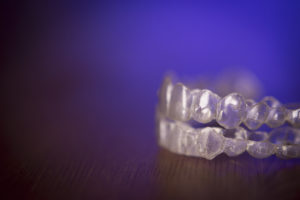
If braces are fit too early on a child, treatment can take longer and be more expensive. For this reason, it’s important to have regular orthodontic visits to monitor tooth and jaw development to ensure that whenever your child receives braces, it’s at the correct time. The braces that your orthodontist recommends will depend on your child’s type of problem that he or she has. There are three types of braces that most children will receive, and they each have different advantages and disadvantages:
- Traditional metal braces – Have steel ties holding the wires between the brackets in place. Cost is driven by what your orthodontist will charge for treatment, including multiple office visits.
- Damon braces – Do not have steel ties, but the brackets themselves hold the wires in place. Typically more expensive and can cost up to $8,000, but you pay for less dental appointments since the braces are self-ligating.
- Invisalign (or other clear or removable aligners) – Fit over the child’s teeth similar to a mouthguard. Your child will receive a number of aligners during the duration of their treatment, so cost is determined by the amount of aligners needed to achieve correction.
Just like adult orthodontics, child orthodontics can cost anywhere between $3,000 and $8,000, depending on what level of correction your child needs. If your child needs to have teeth extracted or be fitted for other appliances, the cost will most likely go up, as well. The way your child complies to orthodontic treatment will also affect the cost. Make sure that they are brushing and flossing everyday so as to avoid tooth decay, which will increase the cost of treatment as your dentist will have to treat around the braces to fix the decay.
Is It Necessary?
As mentioned before, whether your child needs braces or not at an earlier age is dependent upon their mouth structure and how their teeth form. For more information about child orthodontics or if you’re interested in scheduling a consultation, contact Belmar Orthodontics at (303) 225-9016!. Our experienced and highly trained orthodontic staff offers a variety of orthodontic treatments and technology so that you can be confident your children are receiving the best care available.
Why You Should Wear Your Retainer
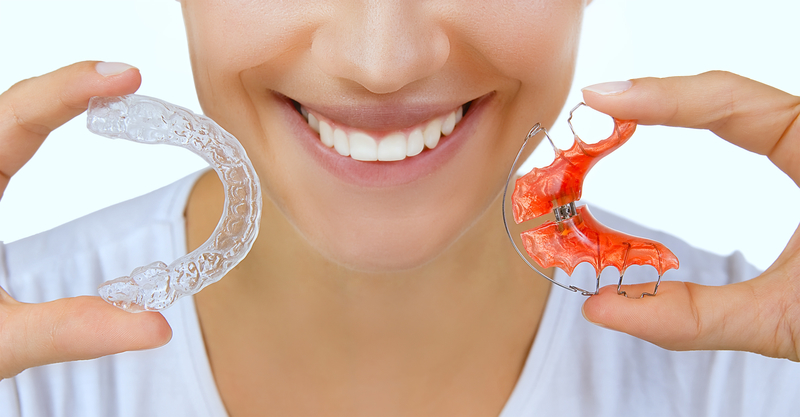
After you have your braces removed, most patients receive a retainer that they wear at night to keep their teeth from moving. But what kind of retainer should you have, and how long should you wear it? Retainers maintain oral health after braces by keeping your teeth in the correct alignment. Many people fail to use their retainers properly, and have to be fitted for braces again. Learn how to prevent your teeth from moving after braces and how to keep your teeth straight!
Purpose of Retainers
After you complete your time with braces, it will be necessary for you to consistently wear the retainer that your orthodontist advises you to wear. A retainer is an apparatus made of plastic and metal that is custom-made for each patient’s teeth and mouth. No two retainers are alike, but they all serve the same function as they seek to keep our teeth aligned properly after our braces are removed. Most people have to wear a retainer after they get their braces off, but many times people wear retainers to close gaps in their teeth, help with a speech impediment, or address specific medical issues. Retainers are especially important after your braces are removed, though, because our teeth will attempt to return to their original position after treatment. Another type of tooth movement that we want to avoid is natural physiological drift, which happens as the width of our smiles gets narrower as we age and our teeth begin to crowd. This occurs to everyone, but consistently using a retainer can prevent this shift in our teeth.
Getting your braces removed is definitely an exciting moment, but keeping your teeth straight is a lifetime effort. Our newly-aligned teeth need time to settle into our soft tissue and jawbone, and wearing your retainer helps this process be successful. Wearing your retainer at night and in between meals allows your teeth to hold their new form and prevents them from shifting back into their old position. As our bodies grow, our teeth follow suit, and retainers maintain the new tooth position that your braces achieved during your treatment. At the beginning, it may be necessary to wear your retainer all day for a few months, or you may only have to wear it at night a few times a week. Your orthodontist will advise you on how long and how often you should wear your retainer, and it is important that you follow all recommendations that you are given.
Types of Retainers
There are two main types of retainers that are used: removable and fixed. Removable retainers can be removed whenever you eat and brush your teeth, but typically must be worn full-time for at least one year after you get your braces removed. Hawley retainers are the most common type of removable retainer and is fit to your mouth shape with wires that wrap around your teeth. Invisible, or Essix, retainers are made of clear plastic that makes it look as if you’re not wearing anything, which increases its aesthetic appeal. Depending on the treatment plan you received during your time wearing braces, your orthodontist may recommend only wearing either of these two removable retainers at night. On the other hand, fixed retainers are those that are cemented to the backs of your teeth and kept in place for several years, even decades. This type of retainer is useful for those people who don’t want to worry about constantly removing their retainer or whose teeth have a higher likelihood of post-braces movement.
Caring For Your Retainer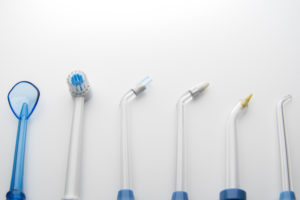
Depending on which type of retainer you use, there are certain instructions that are recommended to properly care for your retainer. For fixed retainers, regular dental checkups are essential to monitor for cavities and clean out any tartar or plaque. When flossing, make sure to use a floss threader that will allow you to go underneath the wire and clean between the teeth. As an additional measure, use a waterpik to rinse out food around the wire. Waterpiks should not replace normal flossing because floss physically removes bacteria from the teeth and gums while a waterpik merely rinses those areas. Although fixed retainers are incredibly strong, they can still break. Try to avoid biting hard foods, like carrots and nuts, with your front teeth to avoid any damage to your retainer. For a removable retainer, make sure to scrub it with soap and a toothbrush daily, or you can try soaking them in denture cleaning tablets or vinegar and water. Whenever you take out your removable retainer, make sure to keep it in a reliable case where it can be protected from pesky pets or avoid being accidentally thrown away. Don’t wear your retainer while playing sports, especially swimming, skiing, or contact sports, and make sure to avoid heat by keeping them away from hot water or hot car dashboards.
Tips For Maintaining Your Oral Health
Retainers play a vital role in keeping our teeth straight and preventing oral health problems, such as teeth crowding, but they aren’t the only recommendation for maintaining good oral health. Make sure to continue flossing and brushing your teeth daily, while visiting with your dentist every six months for a general checkup. For more information on the different types of retainers that are available and what would be the best fit for you, call Belmar Orthodontics at (303) 225-9016 to learn how to improve your smile and oral health!
Choosing A Good Toothbrush
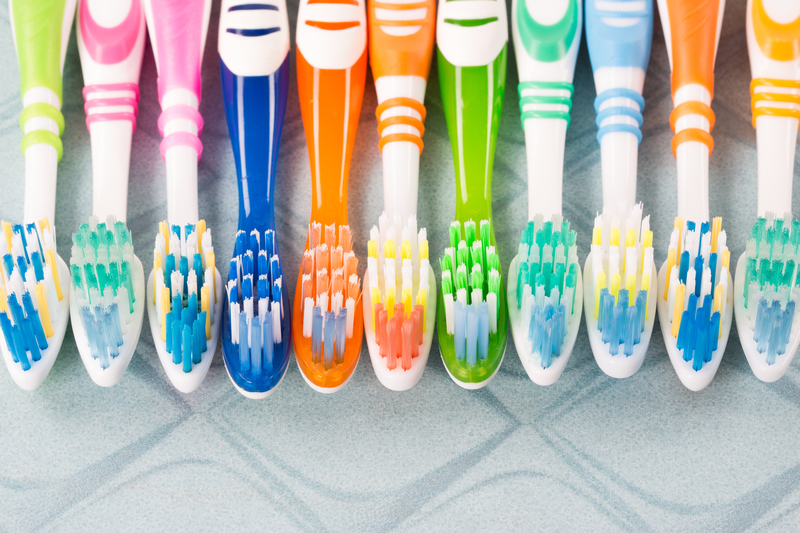
Do you ever look at all the toothbrush options at the store and wonder what the difference is between all of them? Toothbrushes come in all shapes and sizes, and it’s for a reason. They are made to fit certain sizes of mouth. Bristles come in various materials and designs, and there are extra features on some toothbrushes. So what should you choose? Use these tips for the next time you pick out your toothbrush so you know you’re getting a good one for your mouth!
Why So Many Different Kinds?
For something that is so simple to use, there sure are a lot of different toothbrushes out there. Toothbrushes have been around for centuries, with some historians quoting them as being as old as 3000 BC! Ancient civilizations used a “chew stick,” or a twig that had a frayed end in which they would brush their teeth. The common bristled toothbrushes that we are so familiar with didn’t come into existence until around 1498 in China. The bristles that were used in these toothbrushes were actually hog hair that were attached to handles made of bamboo or bone. Even these evolved, though, into the toothbrushes that we use today, but instead with nylon bristles and plastic handles.
Since World War II, oral health has increased in popularity and a variety of different toothbrushes have been invented. But which ones are best? How do you know which toothbrush is for you? Toothbrushes are specifically designed for different sizes and shapes of mouths, plus there are age-specific toothbrushes, like for children, that have smaller (or larger) handles and bristles depending on the age of the person. No matter what toothbrush you use, the principle behind it should be the same: improve your oral health care and prevent disease. Your toothbrush should be helping you do that, if you’re using the right one.
Types of Toothbrushes
There are basically two types of toothbrushes: soft-bristled and hard-bristled. Most dental professionals agree that using a soft-bristled toothbrush is best for cleaning plaque and debris on your teeth. Hard-bristled toothbrushes are not recommended as they are known to wear away your enamel and can lead to gum recession and lesions. Although they do remove more plaque than traditional soft-bristled toothbrushes, hard-bristles cause more damage than good, even when trying to get rid of tough plaque. Toothbrushes with small heads are also great to use because they can get into the hard-to-reach places in your mouth. When deciding between a small-headed or large-headed toothbrush, keep in mind that the size of your mouth should be the determinant for which one you buy. Those people with large mouths should use a full-sized toothbrush head, while those with smaller mouths should utilize a more compact head.
Toothbrushes also vary in the type of the handle (non-slip grip or flexible neck), shape of the head (tapered or rectangular), and style of bristles (rippled, flat, or dome shape). Although there are a variety of kinds, ultimately the best toothbrush is one that fits your mouth and allows you to reach all of your teeth easily. To figure out which one works best for you, trying toothbrushes with different bristle styles or head shapes is recommended until you find one that is most comfortable.
Manual or Electric: Which is Better?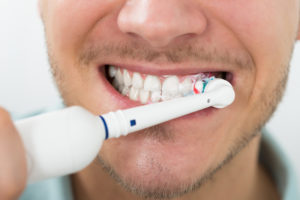
With the advent of the electric toothbrush, many people have been drawn to its ease of use and effectiveness. While manual toothbrushes have been used for centuries, the electric toothbrush is faster and more efficient. If you’re a diligent brusher, manual toothbrushes are a great option, but for those who want the toothbrush to do the work for them, electric is the way to go. Just like manual toothbrushes, electric toothbrushes come in different sizes and have a variety of replaceable heads. Electric toothbrushes are known for having smaller heads than manual, so at the beginning, it may take some time getting used to their small size.
Because of their size, electric toothbrushes are able to clean teeth more thoroughly and get to hard-to-reach areas of the mouth better than manual toothbrushes can. Electric toothbrushes also use different types of bristles movements, such as oscillating/rotating technology, that has been proven to remove more bacteria and plaque than manual toothbrushes. Additionally, electric toothbrushes have a smaller likelihood of hurting your enamel and gums, which is advantageous for those individuals who have sensitive teeth and gums. Whether you choose manual or electric, the most important takeaway is that both fit your mouth size and allow you to clean each individual tooth. If your toothbrush can do both of those things, you’re on your way to achieving great oral health and a nicer smile.
Tips For A Cleaner Mouth
Having the correct toothbrush for your mouth is the first step in maintaining good oral health. But a common question that many have is, “What is the correct way to brush my teeth?” When using a regular soft brush, make sure to angle the brush along the gum line and brush down from the top, then up from the bottom on each tooth in small circles. This motion helps get out the tiny food particles stuck between your teeth, plus it protects your gums from over-brushing. If your gums tend to bleed when brushing, that usually indicates that the gums are inflamed and those areas should actually be brushed more thoroughly and more often. Also make sure that you are brushing your chewing surfaces, the inside of your teeth, and your tongue.
For more tips on how to protect your teeth and maintain a healthier mouth, visit your local provider at Belmar Orthodontics. Change your oral health for the better by calling (303) 225-9016 and setting up your first consult for the comfort, care, and personalized treatment that you deserve!
Braces With Oral Health Problems
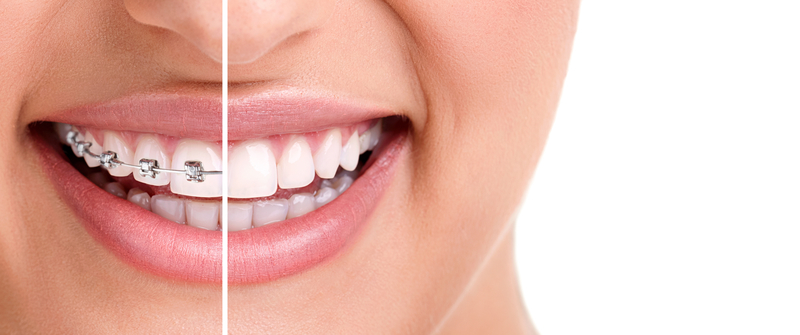
Did you know that your oral health can affect your overall health? Poor oral health can even worsen health conditions you already have such as diabetes or cardiovascular disease. That is because oral health and overall health are highly connected. Your oral issues can become better with braces, but that is only if certain oral health problems are corrected beforehand. Patients can also develop oral health problems if they don’t have the right knowledge with proper braces care. Use these tips to avoid oral health problems with braces and find out how we work around current problems to provide you with a straighter smile!
Oral Health Goals
Did you know that orthodontic treatment can give you a healthier mouth? We know that braces help straighten your teeth, but they can also improve the health of your gums and teeth. When you have crooked and crowded teeth, this makes cleaning your mouth more difficult. This can cause serious oral health problems, such as tooth decay, periodontal disease, and tooth loss. Whether you have straight or crooked teeth, before you let an orthodontist start working on you, there are some important oral health tips to be following before any work begins:
- Eat a healthy diet that limits sugary beverages and snacks
- See a dentist regularly for prevention and treatment of oral disease
- Brush teeth twice a day with fluoride toothpaste
- Floss daily
- Discuss changing certain lifestyle practices, like smoking and using oral piercings
Types of Braces
Braces are a big commitment, and you want to make sure you’re using the correct ones whenever you get them put on. Each of us is a different size and shape, and are mouths aren’t any different. Because of this, there are various types of braces for different sizes and shapes of mouths for children, teenagers, and adults. The four most common types of braces are: traditional, short-term, clear, and Invisalign/ClearCorrect.
Traditional braces are those that we see on a daily basis: a system of wires and brackets that are bonded to our teeth. This type of braces are the most cost-effective, reliable, and are best suited for severe orthodontic issues. Short-term braces are recommended for those patients who wish to align just their front six teeth-the ones that others see the most. These are used for the shortest amount of time (less teeth to align), but there is no adjustment to your occlusion (bite). So if you have a problem with an under/overbite, short-term braces may not be for you. Clear braces are similar to traditional metal brackets except that they use ceramic brackets that match the color of your teeth. These braces have a high aesthetic appeal for those who don’t want to be seen wearing braces, plus they are highly resistant to staining. Invisalign//ClearCorrect straighten your teeth without the traditional wire brackets, and are completely removable, which makes cleaning your teeth a cinch. This type requires more responsibility for the wearer, but if you’re committed to the strict wearing regimen, you can have a straight smile in as little as 12 months!
Taking Care of Your Braces
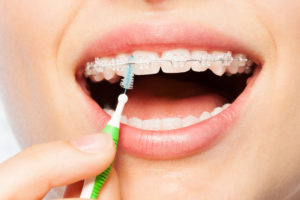
While similar to managing our oral health, maintaining our braces has a few extra steps. To maintain good oral health with braces, it’s important to adopt good oral hygiene throughout the entire process. Brushing after every meal is one of the most important but most overlooked steps in maintaining good oral health. When eating, food particles get stuck in between our teeth and our braces, which can cause staining and bacterial backup between our teeth. Using a regular soft brush in an up-and-down motion on each tooth will do the trick. Secondly, use threadable floss or a floss threader. These tools allow you to get between each tooth and underneath the wires to clean out any food that may be trapped there. Insert the threader between two teeth and move back and forth until the food is released. Lastly, use a proxabrush, or a “Christmas tree brush.” Place the proxabrush between two brackets, below the archwire, and brush up and down. Like the threader, this will also help loosen up any food that may be stuck between your teeth.
A great way to ensure that your braces don’t break and that you don’t get unwanted gunk stuck in them is to watch what foods you’re eating. Foods that are hard, sticky, or high in sugar should be avoided. Eating food that is high in sugar can cause cavities when wearing braces, which can lead to more dental work that you would need to have done. Furthermore, patients with braces should limit between meal snacks and avoid food that could bend the wires, such as caramel, nuts, chewing gum, ice, or popcorn.
When To See An Orthodontist
Now that we understand more about the importance of our oral health, plus the different types of braces, when should we make an appointment with an orthodontist? Many times, we only schedule a time to see an orthodontist whenever our teeth are crooked and we want them straightened. But there are other factors that influence when we should start thinking about getting in to see the doctor:
- Jaws that shift, make sounds, protrude, or are recessed
- Speech difficulty
- Biting the cheek or biting into the roof of the mouth
- Facial imbalance or asymmetry (features out of proportion to the rest of the face)
- Inability to comfortably close lips
- Grinding or clenching of teeth
As mentioned earlier, these are signs that your oral health might not be up to par like it should be. Meeting with your orthodontist and discussing these issues will help them better treat you with one of the four types of braces that we discussed previously. The sooner you get in to see your orthodontist, the sooner any pain or discomfort can be evaluated, treated, and extinguished.
Meet Your New Year’s Resolutions With Our Help!
Belmar Orthodontics can help you on your path towards having a straighter smiles and better oral health. With reputable orthodontists, manageable treatment plans, and services for children and adults, we can help you get the smile that you deserve! Call (303) 225-9016!
Fun Facts About Orthodontics
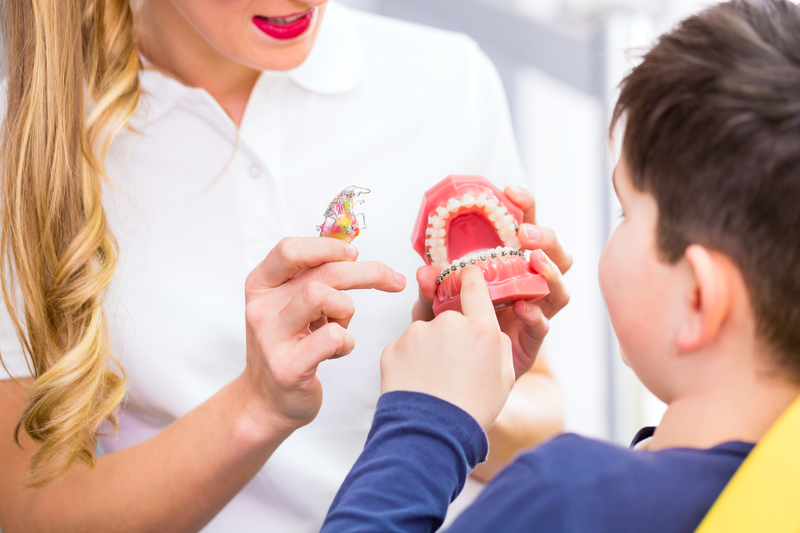
Did you know that an orthodontist is different than a dentist? Orthodontics is a dental specialty all its own, that has different goals and processes than what dentists do. There are many ways to fix the teeth and many methods that have been tried for many centuries. Find out the amazing history of orthodontics and some facts you may not know!
History of Orthodontics
People have been straightening their teeth since the time of the Ancient Egyptians, as can be seen from mummies from this era. Even the Romans and Etruscans used crude orthodontic straightening methods to get a better smile. Many philosophers hypothesized better ways to straighten the teeth. A Roman writer Celsus (1 A.D.) thought the teeth could be pushed into place. Pliny—around the same time—thought the teeth could be filed to be the ideal shape and size.
It wasn’t until 1728 that Pierre Fauchard—or the “Father of Dentistry”—made great strides with orthodontics. He first practiced crudely removing the teeth, replacing them straight, and tying them to other teeth so they could heal straighter. From his influence and others after him, modern orthodontics came to be. Matthaeus Gottfried Purmann developed dental impressions in the 17th century. In the early U.S. years, barbers and medical professionals experimented and performing small orthodontic treatments. This was until the first dental school was established in 1828.
Afterwards, J.S. Gunnell invented a form of headgear that was successful in straightening the teeth. Dental students and professionals figured out how to make a metal appliance to straighten individual teeth, which led to the now-used bracket and wire design in modern orthodontics. Before 1970, orthodontists wrapped wires around each tooth and required that headgear to straighten. This practice involved lots of metal in the mouth, which is why a better form (that we use today) was invented in the following years. Now, in the last 20 years lingual braces (braces behind the teeth) and Invisalign (transparent aligners) were invented to allow patients a hidden apparatus with orthodontics.
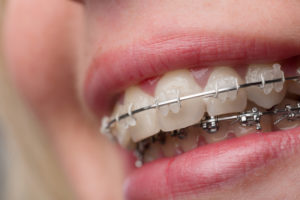
What Do Orthodontists Do?
Did you know that orthodontists are dentists? Every orthodontist is a dentist because they have completed dental school and then some. However, not all dentists are orthodontists. The standard requirements for dentists are to complete 4 years of undergraduate schooling and then 4 years at a dental school. They will have to pass exams and become certified to do dental work. Orthodontists do all of those 8 years, plus they complete 2-3 more years of orthodontics, training in bite and alignment correction and surgical orthodontics. All throughout their career, both dentists and orthodontists must do continuing education courses as well as pass tests to continue working.
An orthodontist will not fix your cavity even though they may spot the signs of tooth decay. Often, an orthodontist works closely with a dentist, as both professionals work on your mouth. What one professional doesn’t do, the other will do. Dentists do everything relating to tooth decay (cavities), gum disease and other oral health diseases as well as remedying dental emergencies. An orthodontist performs services that a dentist doesn’t do such as:
- Bite and alignment correction in children and adults (child orthodontics and adult orthodontics)
- Surgical orthodontics, which is surgery to help remedy a misaligned jaw or bite.
- Braces design, fitting, adjusting and complete process with lingual braces, ceramic (clear) braces, traditional metal, and Invisalign treatment.
- Training in placing temporary anchorage devices, which are tiny screws in the mouth that push, pull, lift or intrude teeth that are being straightened.
- Designing and creating retainer devices to keep bite, alignment and teeth in proper position.
Facts About Braces
- An orthodontist must complete 4 years of dental school, plus 3700 hours or specialized training in orthodontics to get their degree.
- There are more than 19,000 orthodontist members under the American Association of Orthodontics in the U.S., Canada and abroad.
- 1 in 4 people with braces are adults.
- Children make up another 1/4th of people wearing braces to correct bite and alignment.
- Because of modern technology, all four of your dental options (lingual, metal, ceramic and Invisalign) can straighten your teeth in about the same amount of time.
- It is possible to only get braces in either your upper or lower jaw if the other jaw is straight.
- The jaws stop growing as a child ages. That growth stops towards the end of the teenage years around 17 or 18. Straightening the teeth is effective for people after this age, but it may take longer than it would for children.
- Patients generally see their orthodontist every 6-10 weeks for braces adjustments. Patients with severe bite and alignment issues may need to come in more often.
- Orthodontists often usually have “DDS” or “DMD” after their names. This stands for “Doctor of Dental Surgery” and “Doctor of Dental Medicine”. Both are considered equal degrees, but the degree given depends on the dental school attended before orthodontic training.
- Materials used in metal braces are so light that they won’t set off metal detectors in airports.
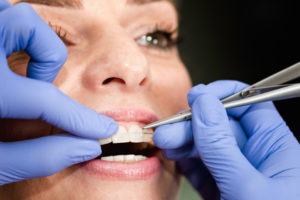
How Do Orthodontics Help People?
If you’ve never been to an orthodontist, you may wonder why you need one. Not everyone may need orthodontics to correct bite and alignment issues, but everyone should see an orthodontist at some point. The American Association of Orthodontics recommends that every person have an orthodontic visit between ages 7 and 8. This is prime time to detect bite and alignment issues that would lead to crooked teeth, speech impediments, oral hygiene diseases, and problems chewing, biting and functioning normally.
When issues are found, they can quickly be corrected so children can grow and develop normally. If a teen or adult wants to straighten their teeth to boost their confidence and success, they can receive braces starting around age 11. For specific questions about our orthodontic services, call Belmar Orthodontics today at (303 225-9016!
Prevent Tooth Enamel Problems During Braces with Proper Orthodontic Care
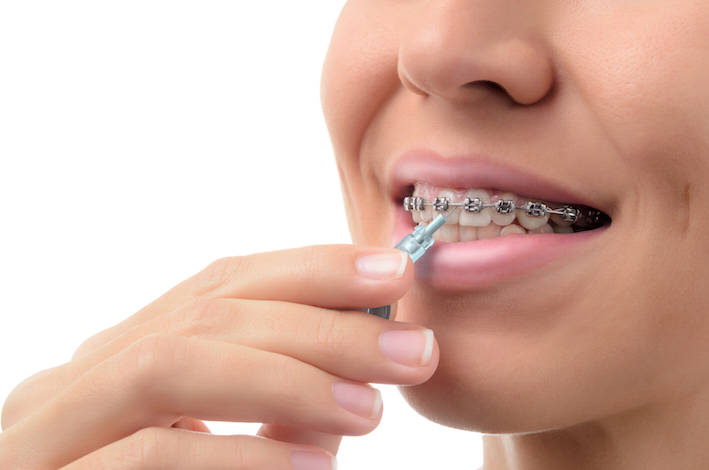
There are many oral health problems that can happen with braces if you are not focused on your orthodontic care and brushing/flossing of your teeth. Your diet can damage your teeth during your orthodontic treatment, which is why we want you to avoid certain foods and drinks. Your diet can damage your teeth during your orthodontic treatment, which is why we want you to avoid certain foods and drinks. Overly acidic or sugary foods and drinks can lead to tooth decay and acid erosion that harms your tooth enamel. We can help you to know what foods and drinks to avoid so you don’t have dental problems during your time with braces!
Increased Risk of Tooth Decay When With Braces
Braces provide patients with a spectacular tool for straightening smiles and correcting jaw problems that impact self confidence and overall oral wellness. Technology has improved over the years allow for less and less of an apparatus on the tooth enamel, but, nonetheless, there is still an apparatus sitting on your teeth for the duration of your treatment. Unless you are wearing removable Invisalign aligners for your orthodontic treatment, your apparatus will consist of wires and brackets. Your wires and brackets are fundamental to the treatment process, but they also can make it difficult to remove food particles that get stuck under, between and in your brackets and wires. If this food is left to fester, the acidic content of the food can eat away at your tooth’s vital tooth enamel.
Combat this type of tooth decay by using the tools your orthodontist recommends for cleaning your teeth. This includes regular brushing, an interdental brush, floss (and floss threaders) and possibly a water flosser to help you use the force of water to rid your mouth of stuck debris.
Acidic Foods and Drinks Erode Tooth Enamel
When it comes to taking care of your teeth with braces, one of the best things you can do is pay attention to what you are putting in your mouth. Thinking about what is coming in contact with your pearly whites can protect your teeth from erosion and decay.
Certain foods and beverages are more acidic (eroding) than others. Low acid foods are better for your teeth even though some of their high acidic counterparts are good for your body. During orthodontic treatment, focus on eating foods that are BOTH good for your body AND your teeth.
Less tooth-friendly foods and drinks include: apples, cherries, oranges, peaches, pears, plums, pineapples, raspberries, tomatoes, pickles, soft drinks, fruit drinks, vinaigrette dressings, BBQ sauces and salsas.
More tooth-friendly foods and drinks include: bananas, mangoes, melons, carrots, cucumbers, lettuce, beets, milk, water, meat, poultry, seafood, eggs, crackers, soups and pasta.
Orthodontic Care: Cleaning Teeth at Home
If ever there was a time to skimp on your oral hygiene it is NOT when you have braces. Diligent home care can make a significant difference in your smile results post-orthodontic treatment. Here are three steps to follow to help you find success:
- Brush after every meal. Because your braces can easily attract and trap food particles, brushing after each meal can help prevent staining and reduce the potential for bacteria buildup. To brush teeth with a regular soft brush, brush down from the top, then up from the bottom on each tooth with a bracket.
- Use a threadable floss or a floss threader. (If using a floss threader, thread regular floss through the eye of the threader, the same way you would with a sewing needle and thread.) Using the small or the pointed end, insert the floss or floss threader between the teeth, but below the archwire. Gently move it back and forth until it is able to thread the floss between the teeth. Once in place, you can floss the two teeth on either side of where you have inserted the floss, taking care not to apply force or pressure against the archwire. Repeat between all teeth.
- Use a proxabrush (interdental brush). After brushing with a toothbrush, use a proxabrush, commonly referred to as a “Christmas tree brush,” to clean between each bracket. Place the proxabrush between two brackets, below the archwire, brushing up and down. After several strokes, repeat this motion by inserting the brush from the opposite side (either down from the top or up from the bottom).
If you are having ANY difficulties cleaning your teeth with these above tools, contact our office so we can help!
Schedule an Orthodontic Care Consultation to Protect Your Tooth Enamel
Your time with braces will come and go in a flash, although you might not believe that in the beginning. The efforts you make from day one with your braces to protect your tooth enamel will show in the results of sparkling, white, strong, healthy teeth. Our friendly staff at Belmar Orthodontics is available to train you in methods and tools for keeping your teeth clean and strong. Make sure to keep your regular cleaning and check-up appointments so we can examine your teeth and make suggestions for improvements. Make an appointment by contacting our office today at 303.225.9016. We are excited to meet you and help you reach your smile goals!
Child Orthodontics Compared to Adult Orthodontics
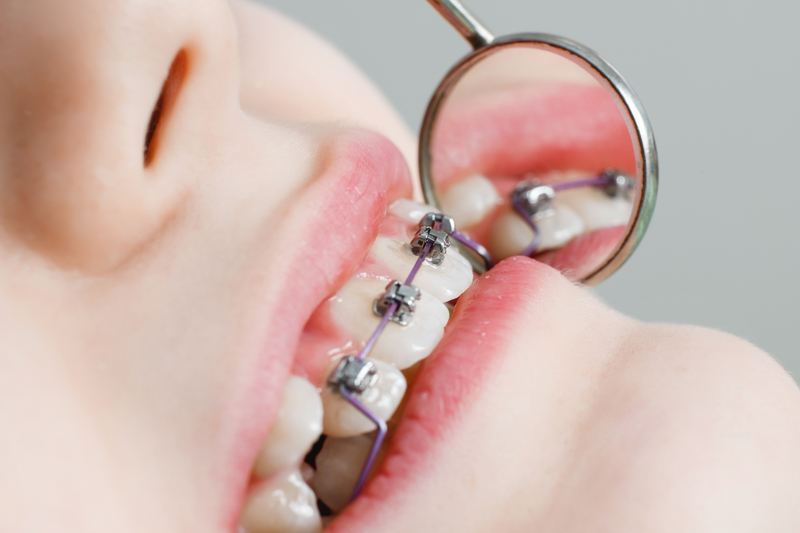
Did you know that about 1/4th of all people with braces are children? Millions of Americans receive orthodontic treatment for bite and alignment correction and for straightening the teeth. However, adults require treatment differently and for longer than a child would need, and child orthodontics have different goals for patients than adult orthodontics do. Both of these areas of orthodontics differ, but are also very similar in techniques used to create a beautiful smile.
Orthodontic Treatment
Orthodontic treatment is one of the easiest ways to help improve your health. Braces can help correct major oral health problems and can help avoid dental emergencies in the future. In children and adults, braces straighten the teeth so that they are aligned properly for speech, eating, biting and more. Straighter teeth are easier to clean and easier to manage, which leads to better health. Teeth must come in at specific places in the mouth for both children and adults. Child orthodontics focuses on that proper bite and tooth placement, and adult orthodontics seeks to improve the look of a smile.
Child Orthodontics
Did you know that children often wear braces, only to get them again as adolescents? Child orthodontics is a popular orthodontic option for at least 1/4th of braces wearers. Dentistry has been around enough centuries to know that the teeth, bite, alignment and growth happen in a specific way. Teeth must come in at the right spot and must be aligned in a specific manner in the jaw. As a child begins to get their baby teeth, some may be crooked. Depending on oral health conditions, and problems such as thumb-sucking, the shape of the teeth and bite can change.
Some children will have teeth that protrude outward, inward, or teeth that are in various directions. This leaves them open to the risk of broken or fractured teeth, tooth decay and problems with speech and development. Child orthodontics is the first phase of getting braces early. It focuses on getting the jaws lined up correctly and the teeth resting on each other in the right way. Once that happens, the baby teeth can fall out and the adult teeth can smoothly come into place. Child orthodontics will correct the major issues a child’s mouth has when they are around 7 or 8 years old. Starting at 11 and later, braces will seek to make the teeth look more attractive.
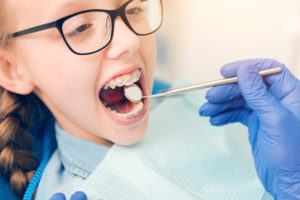
Adult Orthodontics
Most people think that teens make up the majority of patients with braces. However, adult orthodontics is very popular as well, with about 1/4th of all orthodontic patients being adults. There are more adults wearing orthodontic appliances than you realize, especially because of the “invisible options” they have that children don’t have.
Adults have a harder time with straightening their teeth than children do. By adulthood, the mouth and jaws have stopped growing, making them less moldable than a child’s jaws. The treatment that would have been easy for a child may take twice as long for an adult, or may require surgical orthodontics to achieve a straight smile, or proper bite and alignment. However, adults get the benefits of Invisalign treatment and lingual braces, which most children can’t have.
Invisalign is an “invisible” straightening option for adults and teens that uses a strong, clear aligner to straighten the teeth. Digital scanning creates customized aligners that a patient changes out ever 1-2 weeks, which slowly shift the teeth into their proper place. This invisible option allows adults and teens to brush, floss, eat and play sports without brackets and wires in the way. Lingual braces is another “invisible” straightening option. It has metal brackets and wires, except they’re placed on the back of the teeth. Only an adult can use these, as the baby teeth are not large enough for lingual braces to fit. Both adult orthodontics and child orthodontics correct bite, alignment and tooth issues, but the options available to the two age groups differ slightly.
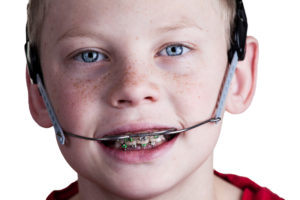
Why Choose Either Option?
When considering orthodontic treatment, there are various aspects you have to think about that include cost, health changes, aesthetic appeal and more. Many people think that braces are very expensive, when they are actually quite affordable. Your family may even save more money over time because of the oral health problems that are avoided by proper orthodontic treatment. A major reason so many people have orthodontic treatment is that they want to improve their smiles. Not only does a straight smile look beautiful, but it helps patients feel more confident. Studies show that child orthodontics helps children feel more confident in school and they do better academically.
Braces can correct speech problems caused by bite and alignment issues. They can straighten the teeth, making them easier to clean, and thus reducing problems with tooth decay, gum disease and bad breath. People socially perceive patients in a more positive way if their smiles are straighter and healthier. No matter if you choose orthodontic treatment for aesthetic appeal or for health reasons, the benefits are worth the time, effort and money you put into your treatment.
Conservative Treatment
Dr. Hardy practices a conservative approach to orthodontic treatment. While it is important for children to have an early orthodontic assessment to look for serious dental concerns (around age 7), the majority of children will not require orthodontic treatment before age 11. Your child might need child orthodontics or they may only need orthodontic treatment as a teen. Some people are naturally born with straight teeth that don’t pose them a problem, or their teeth start to shift later on in life. Whether your child needs child orthodontics or you need adult orthodontics, call Belmar Orthodontics today at (303) 225-9016 for your free consultation!
Your Braces from Start to Finish
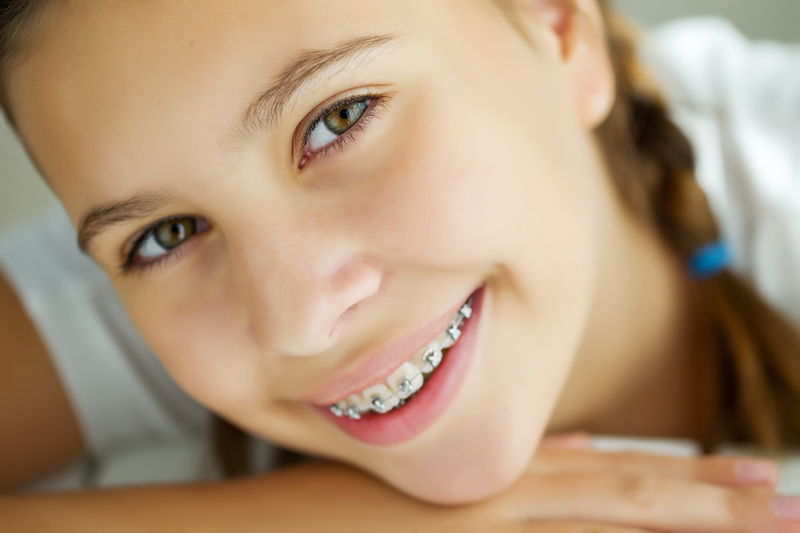
There are many things to think about when deciding to receive your braces. What type of braces should you choose? What age should you receive those braces? Then, after deciding what method of teeth straightening you want, you then have to learn how to properly care for your teeth. You will also have to get used to sometimes having sore teeth after your appointments and fitting in seeing the dentist. We can help you to know about your braces appliance from choosing a braces type, cleaning them, and avoiding tooth decay while you get a straighter smile.
Choosing Your Braces Style
Receiving braces is an exciting time for many people. It is the start of a better smile and a better you. But before you can get that straighter, more beautiful smile, you have to choose what style of braces you want. We offer:
- Traditional Metal Braces – These are the classic metal bracket and wire option that is most commonly chosen by patients. Patients who chose this option come in to have their wires tightened at each appointment.
- Ceramic Braces – These braces are a close cousin to metal braces. They have the same bracket and wire design of metal braces, except that they are made out of ceramic material. This helps decrease demineralization during your orthodontic treatment. Ceramic material is also naturally white, helping these braces to blend in with your teeth more than metal would.
- Lingual Braces – These are metal braces that are placed on the back of your teeth. Instead of just a square bracket, the metal must be custom-made to the shape of the back of your teeth. This is a discrete option that adults and teens love.
- Invisalign Treatment – This is the most invisible option available to our patients. Invisalign is a series of transparent aligners that you wear at night and throughout the day. You can remove them for eating, playing sports, cleaning your teeth and more.
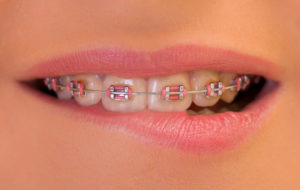
Getting Your Braces Put On
After you’ve chosen the style of braces you want, you need to have them fitted to your mouth. 3 out of the 4 options available to you will be bonded to your actual teeth. At our office, we make sure your teeth are thoroughly cleaned and dried before we bond brackets to them. With metal braces, we will use a cement bonding glue to adhere a metal bracket to the center of each of your teeth. Your back molars might receive a band that goes all the way around the tooth.
Once the metal bracket is cemented to the center of each tooth, we will pass a small metal archwire through each bracket both on top and on bottom. In the end, you will end up with a wire across the teeth on your upper jaw and across the teeth on your lower jaw. The glue we use may taste a bit unpleasant, but it is otherwise harmless. The entire process of getting your brackets and wires placed on your teeth will be between 1 and 2 hours.
The Process for Other Options
Depending on what option you have chosen, your braces process might be a bit different. Ceramic braces are applied the same way that metal braces would be, as they too consist of brackets and wires. However, if you choose to get lingual braces, we can’t simply place brackets on the backs of your teeth. Once Dr. Hardy has determined that you are an ideal candidate for lingual braces, he will take impressions of your teeth. He then sends them to a lab so that your brackets and wires can be custom made. The braces will then be bonded behind your teeth at a separate appointment.
For Invisalign treatment, we design a series of transparent aligners that you will switch out each week. We can take digital impressions of your mouth that we will use to design your aligners. We use a digital scanning system that sends images to a state-of-the-art printing machine. Then, each week you will have new aligners that you will simply replace. It’s that easy!
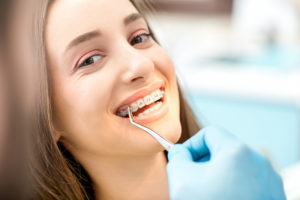
Your Orthodontic Experience
Most patients will have braces for 18-24 months. Some people don’t like braces, but the majority of people do. You can choose the style of your braces and if you want them to be hidden or noticeable. You can also dress up your braces with colorful bands if you so desire. Braces require more care than what you are used to. You must take more time with brushing and flossing, even using tools such as a waterpik, proxabrush and floss threaders to fully remove food from your braces. You must clean your teeth thoroughly to avoid tooth decay during your time with braces. We can show you how to do all of this at our office.
Each patient will come in every 4-6 weeks for orthodontic checkups. This is where we will examine your braces and how your teeth are moving. You will experience initial soreness and discomfort after you first get your braces. You might have this discomfort every time your braces get tightened as well. A simple over-the-counter pain reliever should help you as well as eating soft foods. Having braces changes life a little bit when it comes to cleaning your teeth (which takes longer), but the benefits far outweigh everything else. At the end of your treatment, you will have an amazing, beautiful smile that is sure to wow everyone around you. If you want to know more about your braces options, or want to get started on your journey today, call Belmar Orthodontics today at (303) 225-9016!
